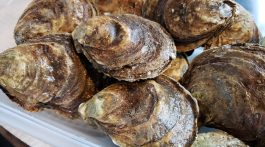Local and farm to table are the buzzwords in the food world these days. Everyone wants to get the freshest and most local food right from the source. The local crop along the Fairfield County coast is oysters – boat to table. They are available on many area restaurant menus and are sought after across the country. But oysters are not an integral part of our coastal culture and cuisine like they used to be. We should be eating more!
Norwalk is the Oyster capital of Connecticut. Six days a week – year round – oyster boats go down the Norwalk channel to the beds in the harbor and nearby waters. After hours of hard work, they return with a mountain of sweet, plump, briny oysters on the deck ready to be sorted, cleaned and shipped around the country for seafood lovers to enjoy on the half shell, baked, stewed or scalloped.
Since the 19th century, oystering has been an important source of income for local watermen. Norwalk harbor with its sheltering Islands, accessible beds and proximity to New York has been an ideal place to harvest oysters as a local food source and a commercial product to be sent to market. Oyster shell middens (piles of discarded shells) along the Connecticut coast tell the story of Native American life and how important oysters were to pre-Columbian culture as well.
Oysters transitioned from everyday food to a special occasion and restaurant offering as supplies declined due to the advance of civilization along coastal waters. Gourmands of the 19th century were known to eat dozens at a sitting. According to Mark Kurlansky, author of The Big Oyster: History on the Halfshell, in 1860 roughly 12 million oysters were sold in New York markets and by 1880, production was up to 700 million a year with oysters being shipped all over the country packed in wooden barrels and crates. At that time, oysters were a common street food sold cheaply from carts, stands and in bars in New York City.
Sadly, oysters have moved out of every day food culture. Nowadays they are available and even experiencing a rise in popularity, but they’re no where near as ubiquitous as when they were the hamburger, pizza, or fried calamari of their time.
The two major oystering companies in Norwalk are from the same family. Tallmadge Brothers on the West side of Norwalk harbor was founded by the Bloom twins, Norman and Hillard, in 1947. The company can trace its Norwalk oystering lineage back to 1875. On the East side of the Harbor, Norm Bloom and Son is a branch of Bloom Brothers family tree. There are many other independent oystermen in and around the town, as well.
I recently visited the docks at Norm Bloom and Son and watched one of their fleet unload the day’s catch. Oystering goes on in all weather and chunks of ice from the recent freeze surrounded the boat as the oysters were shoveled into baskets and lifted onto the dock. Norm took me through the sorting, cleaning and packaging operations. He talked with pride of his family’s connection to the water and the importance of Norwalk harbor to local oystering
As with any farmer, Bloom is a steward of his land, in this case more than 5000 acres under water where he grows his crop. He supports a vigorous program to monitor water conditions in the harbor and has even built a water testing lab in his plant. He works closely with the sound keeper, other environmental groups and city departments to maintain the best possible water quality and conditions for oystering in Norwalk and up and down Long Island Sound.
The Bloom family’s oysters are delicious – plump and tangy with a briny flavor that tastes like the sea. Norwalk oysters are shipped around the country and the world. Copps Island, the brand for Norm Bloom and Son, gets top billing on the menu at the legendary Grand Central Oyster Bar in New York. Many local restaurants feature Copps Island Oysters including The Red Barn, Blackstone’s Steakhouse, The Whelk, Oak + Almond, NoLa and B.J. Ryan’s Banc House.
Soon, I’ll talk more about cooking and eating oysters including recipes from local chefs, and some tips on buying and opening. In the meantime, let me know your favorite way to eat Norwalk oysters.












Can’t wait for those recipes.
We had the oysters at Oak and Almond, they were the best.